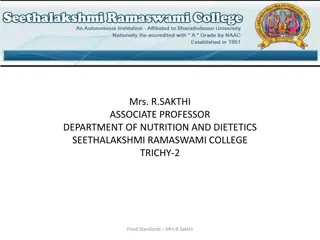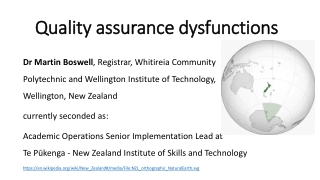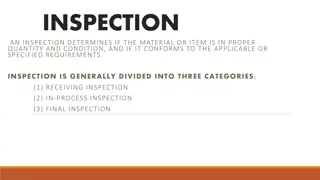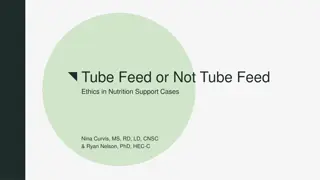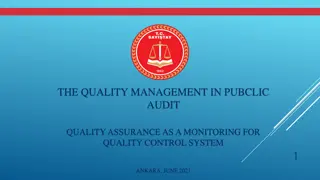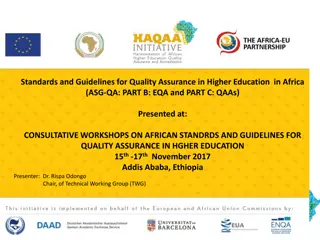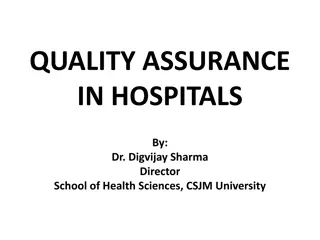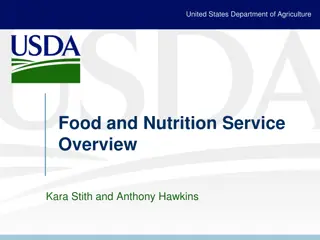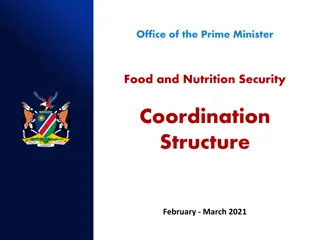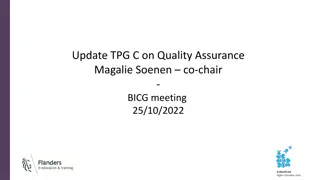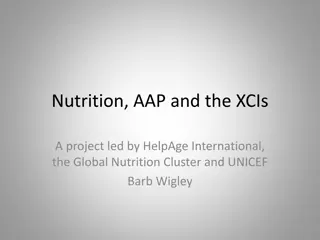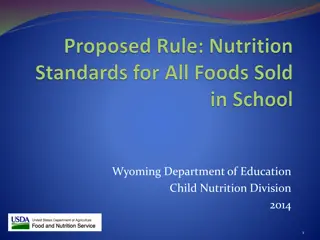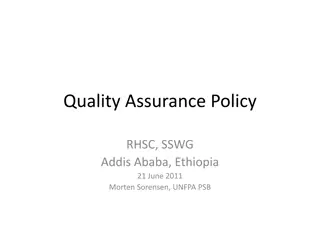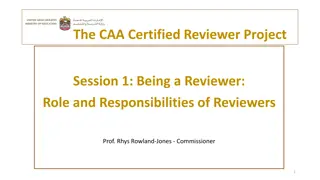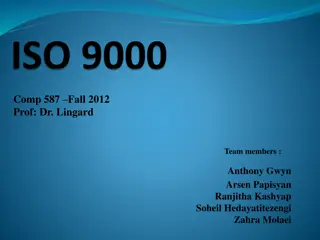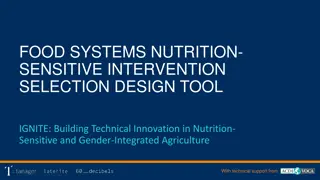Understanding Food Standards and Quality Assurance in Nutrition and Dietetics
Explore the world of food standards and quality assurance with Mrs. R. Sakthi, an Associate Professor in the Department of Nutrition and Dietetics at Seethalakshmi Ramaswami College, Trichy. Learn about the regulations set by international bodies like the Codex Alimentarius Commission, the standards for various food products and additives, and specifications for starchy foods like arrowroot starch and sago. Discover the stringent criteria for spices and condiments such as asafoetida, and delve into the intricacies of ensuring quality and safety in natural and processed foods.
Download Presentation

Please find below an Image/Link to download the presentation.
The content on the website is provided AS IS for your information and personal use only. It may not be sold, licensed, or shared on other websites without obtaining consent from the author. Download presentation by click this link. If you encounter any issues during the download, it is possible that the publisher has removed the file from their server.
E N D
Presentation Transcript
Mrs. R.SAKTHI ASSOCIATE PROFESSOR DEPARTMENT OF NUTRITION AND DIETETICS SEETHALAKSHMI RAMASWAMI COLLEGE TRICHY-2 Food Standards Mrs.R.Sakthi
FOOD STANDARDS Food Standards Mrs.R.Sakthi
FOOD STANDARDS Ensures quality and safety of natural and processed foods. Have been formulated and enforced by Law. An International body was established Codex Alimentaires Commission(CAC) Objectives of this body To develop International and Regional Food standards and publish them as food Code. Food Standards Mrs.R.Sakthi
The PFA has laid down standard specifications for the following groups of food products and food additives. Milk, ghee, butter, khoa and dahi. Edible oils and fats including vanaspathi and margarine. Tea, coffee, cocoa and chicory. Wheat flour, cereals, pulses, semolina and sago. Bread, biscuits, pastries and allied products. Fruit and vegetable products and non-alcoholic beverages. Sugar, jaggery, honey and syrup. Confectionery, sweetmeats, chocolate and toffee. Custard powder, corn flakes, Baby food and milk powder, condensed milk and cheese. Spices and condiments. Food additives, flavouring agents, antioxidants, edible colours, emulsifying and stabilizing agents, preservatives, artificial sweeteners, permitted in food products. Food Standards Mrs.R.Sakthi
STARCHY FOODS ARROWROOT STARCH, SAGO Curcuma angustifolia Maranta arundinacea Arrowroot starch seperated and purified starch from the above rhizomes. Indian Arrowroot Curcumaangustifolia Arrowroot Sago small hard globules/pearls made from starch of these plants. Manihot utilissima tapioca sago STANDARDS FOR SAGO Shall be free from any extraneous matter (including natural colours). Total ash (on dry basis) not more than) shall not exceed 0.1% 0.4% Ash insoluble in dilute HCl (on dry basis Food Standards Mrs.R.Sakthi
SPICES AND CONDIMENTS ASAFOETIDA (Hing or Hingra) ASAFOETIDA Ferula rubricaulis Asafoetida Oleo gum resin obtained from the rhizome and roots of the above species. STANDARDS FOR HING AND HINGRA Hing plant Criteria Hing Hingra Total ash content (shall not exceed) 15% by weight 20% by weight Ash insoluble in dil.HCl (shall not exceed) 2.5% by weight 8% by weight Alcoholic extract(with 90% alcohol) (USP method) (shall not be less than) 12% 50% Starch (shall not exceed) 1% by weight 1% by weight Food Standards Mrs.R.Sakthi
COMPOUNDED ASAFOETIDA OR BANDHANI HING Compounded asafoetida Bandhani Hing Composed of one or more varieties of asafoetida and gum arabic, atta or rice flour or both. It shall not contain Colophony resin Galbonum resin Ammonia cum resin Any other foreign resin Coal tar dyes Mineral pigment More than 10% total ash content More than 1.5% ash insoluble in dil.HCl Less than 5% alcoholic extract (USP method) Food Standards Mrs.R.Sakthi
TURMERIC (HALDI) Dried rhizome or bulbous roots of this plant Shall be free from lead chromate . No other artificial colouring matter. Proportion of extraneos matter shall not exceed 2% by weight. Curcuma longa Turmeric Powder obtained by grinding the dried rhizomes or bulbous roots. Free from artificial colouring matter. Turmeric Powder SPECIFICATIONS FOR TURMERIC POWDER Moisture not more than 13% by weight. Total ash not more than 9% by weight. Ash insoluble in dilute HCl not more than 1.5% by weight. Test for lead chromate Negative. Total starch not more than 60% by weight. Food Standards Mrs.R.Sakthi
CURRY POWDER Curry powder Powder obtained from grinding clean, dried and sound apices of aromatic herbs and seeds such as black pepper, cinnamon, cloves, coriander, cardamom, chillier, cumin seeds fenugreek, garlic, ginger, mustard, poppy seeds, turmeric, mace, nutmeg, curry leaves, white pepper, saffron and aniseeds. Contain added starch and edible common salt. Proportion of spices - Shall be not less than 58% by weight. Free from dirt, mould growth and insect infestation. Shall be free from any added colouring matter and preservatives. SPECIFICATIONS Moisture - not more than 14% by weight. Volatile oil not less than 0.25% on dry basis. Non volatile ether extract not less than 7.5% by weight on dry basis. Edible common salt not more than 5% by dry weight on dry basis. Ash insoluble in dil.HCl not more than 2% by weight on dry basis. Crude fibre Not more than 15% by weight on dry basis. Lead Not more than 10 ppm on dry basis. Food Standards Mrs.R.Sakthi
COFFEE Robusta coffee Coffea Arabica Coffea liberica Coffea Excelsa Coffee means the seed of the above plants. Freed from all but a small portion of its spermoderm by decortication. Roasted coffee Properly cleaned green coffee which has been roasted to a brown colour , developed its characteristic aroma. Ground coffee Powdered product obtained from roasted coffee, free from husk. STANDARDS Total ash not less than 3.5% and not more than 5% by weight. Ash insoluble in hot dil.HCl not more than 0.1%. Alkalinity of the ash per gram not less than 3.4ml and not more than 4.4ml of N/10 acid. Aqueous extract not less than 25% and not more than 32%. Food Standards Mrs.R.Sakthi
CHICORY Roasted chicory powder obtained by roasting the cleaned and dried roots of the plant. With or without addition of edible fats and oils or sugar like glucose or sucrose in proportion not exceeding 2% by weight. Free from artificial colouring and flavouring matter. Cichorium intybus Chicory Powder STANDARDS oTotal ash not less than 3.5% and not more than 10%. oAsh insoluble in dil.HCl not more than 2.5% on dry basis. oWater soluble matter Not less than 50% on dry basis. COFFEE CHICORY MIXTURE oPure ground coffee mixed with roasted and ground chicory. oNo rancid or obnoxious flavour. oCaffeine not less than 0.6%. oAqueous extract not more than 50%. Food Standards Mrs.R.Sakthi
COCOA BUTTER Theobroma cacao Cocoa butter Fat obtained by expression from the nibs of this plant. Free from other oils, fats, mineral oil and added colours. STANDARDS Free fatty acid(oleic acid) not more than 1.5%. Iodine value 32-42 Melting point 29oC-34oC. Butyro refractometer reading at 40oC 40.9 to 48.0. Saponification value 185 to 200. Food Standards Mrs.R.Sakthi
COCOA POWDER Powder which is the partially defatted product derived from the cocoa bean. Free from rancidity, dirt, filth, insect fragments or fungus infestations. STANDARDS (on moisture and fat free basis) Total ash not more than 14% Ash insoluble in dil.HCl not more than 1% Alkalinity of total ash not more than 6% Food Standards Mrs.R.Sakthi
TEA camellia Powder Tea Derived from exclusively from the leaves, buds and tender stems of the plant. SPECIFICATIONS Total ash 5 to 8%. Total ash soluble in boiling distilled water not less than 40% of total ash. Ash insoluble in HCl not more than 1%. Alkalinity of soluble ash not less than 1% and not more than 2.2%. Crude fibre not more than 17%. Shall not contain any added colouring matter. Food Standards Mrs.R.Sakthi
FATS AND OILS ANIMAL FATS Goat Fat Lard Beef Fat Hogs Beef fat or suet Fat obtained from a beef carcass. Goat fat rendered fat from goat. Lard Rendered fat from hogs. Criteria Saponification value Iodine value Beef fat 193- 200 35 - 46 Goat fat 193 196 36 - 45 Lard 192 198 52 - 65 Food Standards Mrs.R.Sakthi
VEGETABLE OILS Buryro refractometer reading Saponification value (not less than) Iodine value Free fatty acid(as oleic acid)(not more than) 34.0 35.5 250 7.5 10.0 3.0% Coconut Oil Buryro refractometer reading Saponification value (not less than) Iodine value Free fatty acid(as oleic acid)(not more than) 57.9 60.2 190 198 98 112 1.0% Cotton Seed Oil Buryro refractometer reading Saponification value (not less than) Iodine value Free fatty acid(as oleic acid)(not more than) 54.0 57.1 188 196 85 99 3.0% groundnut oil Food Standards Mrs.R.Sakthi
Buryro refractometer reading Saponification value (not less than) Iodine value Free fatty acid(as oleic acid)(not more than) 58.0 60.5 168 177 96 108 3.0% Mustard Oil Buryro refractometer reading Saponification value (not less than) Iodine value Free fatty acid(as oleic acid)(not more than) 6.5 65.4 185 190 115 120 3.0% sesameseed oil Buryro refractometer reading Saponification value (not less than) Iodine value Free fatty acid(as oleic acid)(not more than) 61.7 69.5 189 195 120 141 1.25% Soybean oil Food Standards Mrs.R.Sakthi
Buryro refractometer reading Saponification value (not less than) Iodine value Free fatty acid(as oleic acid)(not more than) 61.0 65.0 185 193 125 135 3.0% Niger Seeds Buryro refractometer reading Saponification value (not less than) Iodine value Free fatty acid(as oleic acid)(not more than) 69.5 74.3 188 195 >170 2.0% Linseed oil Buryro refractometer reading Saponification value (not less than) Iodine value Free fatty acid(as oleic acid)(not more than) 49.5 52.7 187 196 58 70 2.0% (mahua)oil Food Standards Mrs.R.Sakthi
Buryro refractometer reading Saponification value (not less than) Iodine value Free fatty acid(as oleic acid)(not more than) 53.0 56.0 185 196 79 90 3.0% Olive oil Buryro refractometer reading Saponification value (not less than) Iodine value Free fatty acid(as oleic acid)(not more than) 60.0 64.0 186 194 133 146 3.0% Poppy Seed Oil Buryro refractometer reading Saponification value (not less than) Iodine value Free fatty acid(as oleic acid)(not more than) 62.4 64.7 186 196 135 146 3.0% Safflowerseed oil Food Standards Mrs.R.Sakthi
MARGARINE Edible oils 80% ; Moisture 16%; Til oil not less than 5% Prepared with or without edible common salt. Free from rancidity, colouring flavouring substances, mineral oil or animal fat. Vitamin A not less than 25I.U./gm. May contain permitted emulsifying and stabilising agents. VANASPATHI Refined edible vegetable oil or oils. Prepared by hydrogenation from ground oil, cottonsed oil and sesame oil or mixtures. STANDARDS No harmful colouring, flavouring, deleterious matter. No colour or flavour resembling ghee colour. Moisture not more than 0.25% ; Melting point 31oC to 37oC; Free fatty acid 0.25% Contain raw or refined sesame(til) oil not less than 5%; Vitamin A 25 I.U. No antioxidant, synergist, emulsifier should be added. Food Standards Mrs.R.Sakthi
FRUITS AND FRUITS PRODUCTS Fruit syrups Minimum% of total solids Minimum % of fruit juices or prepared fruit 65 25 Squashes Minimum% of total solids Minimum % of fruit juices or prepared fruit 40 25 Fruit preserves Minimum% of total solids Minimum % of fruit juices or prepared fruit 68 55 Fruit: jams, jellies, marmalades Minimum% of total solids Minimum % of fruit juices or prepared fruit 65 45 Fruit chutney Minimum% of total solids Minimum % of fruit juices or prepared fruit 50 40 Food Standards Mrs.R.Sakthi
Candied Fruit / Glazed fruit and peel Candied Fruit Candied orange and lemon peels Total sugar (%) Reducing sugar (%) of total sugar Not less than 70 Not less than 25 - Shall be free from moulds, insect and rodent contamination TAMARIND CONCENTRATE Tartaric acid (%) Ash soluble Total soluble solids(not more than) 9.0 0.8% 65% Food Standards Mrs.R.Sakthi
BOTTLED OR CANNED FRUIT Head space in can not more than 1.6cm Drained weight not less than 50% No artificial colour. No positive pressure. No sign of bacterial growth when incubated at 37oC for 1 week BOTTLED OR CANNED VEGETABLE Head space in can not more than 1.6cm Drained weight not less than 55% No artificial colour. No positive pressure. No sign of bacterial growth when incubated at 37oC for 1 week Food Standards Mrs.R.Sakthi
TOMATO PRODUCTS Min.%-total soluble solids free of salt Mould count(not in excess of) Juice 5 Soup 7 30% tomato juice Tomato Soup Min.%-total soluble solids free of salt Mould count(not in excess of) Paste 25 Puree 9 60% Min.%-total soluble solids free of salt (not in excess of) Mould count - 40% Yeast 125 per 1/60c.mm Bacteria-100million/ml Tomato paste tomato puree 25 Min. acidity -1% tomato ketchup Min.%-total soluble solids free of salt (not in excess of),Mould count - 40%,Yeast 125 per 1/60c.mm Bacteria-100million/ml Tomato Sauce 15 (Min.acidity 1.2% Food Standards Mrs.R.Sakthi
MILK Cow s milk/Buffalo s milk/combination. Milk fat 4.5%; Milk solids non fat 8.5% (abstraction/add. of milk fat/add. of skimmed milk/add.of recombined /reconstituted skimmed milk). Shall be pasteurized. Show a negative Phosphatase test. Recombined Milk Homogenised product prepared from milk fat, non-fat milk solids and water. Shall be pasteurized. Show a negative Phosphatase test. Milk fat 3.0; Milk solids non-fat 8.5 Mixture of cow s/buffalo milk /both with skimmed milk Mixture of cow s/buffalo milk /both with non-fat milk solids or milk powder, or water. Partial abstraction/addition of fat from / to milk. Shall be pasteurized. Show a negative Phosphatase test. Milk fat 3.0; Milk solids non-fat 8.5 Food Standards Mrs.R.Sakthi
DOUBLE TONED MILK Mixture of cow s/buffalo milk /both with non-fat milk solids or milk powder, or water. Partial abstraction/addition of fat from / to milk. Shall be pasteurized. Show a negative Phosphatase test. Milk fat 1.5; Milk solids non-fat 9.0 SKIMMED MILK Almost all the milk fat has been removed Milk fat not more than 0.5; Milk solids non-fat 8.7 Food Standards Mrs.R.Sakthi
Cream MILK PRODUCTS Product of cow s/buffalo milk/both. Contains not less than 25% milk fat. Malai Prepared by boiling and cooling cow s/buffalo milk/both. Contains not less than 25% milk fat. Dahi Product obtained from pasteurized /boiled milk by souring. May contain cane sugar. Minimum %age of milk fat and milk solids non fat. Food Standards Mrs.R.Sakthi
Paneer Product of cow s/buffalo milk/both by precipitation with sour milk or lactic acid or citric acid. Moisture not more than 70% Milk fat not less than 50% Skim milk Paneer Product of cow s/buffalo skim milk/both by precipitation with sour milk or lactic acid or citric acid. Moisture not more than 70% Milk fat not less than 13% Cheese Product obtained by draining after coagulation of milk with an agent. It contains coagulating agent, NaCl, CaCl2 not exceeding 0.02% Annatto, emulsifiers, stabilizers, sodium citrate, ortho phosphoric acid and polyphosphoric acid- not exceeding 0.2% Wax used for covering not harmful. Colours Permitted colours. Food Standards Mrs.R.Sakthi
khoa Product obtained from cow s/buffalo/goat/sheep milk/combination by rapid drying. Milk fat not less than 20%. ice cream Kulfa Kulfi Frozen product obtained from cow s/buffalo milk /combination. With/ without cane sugar, eggs, fruits, fruit juices, preserved fruits, nuts, chocolate, edible flavours, permitted food colours. Permitted emulisifiers and stabilizers not exceeding 0.5%. Milk fat not less than 10% ; Protein 3.5%; total solids 36% Food Standards Mrs.R.Sakthi
Evaporated Milk (Condensed milk unsweetened) Product obtained from cow s /buffalo milk / combination/standardised milk by partial removal of water. May contain calcium chloride, citric acid and sodium citrate, sodium salts of ortho phosphoric acid and polyphosphoric acid not exceeding 0.3%. Milk fat not less than 8%: Milk solids not less than 26%. Condensed milk sweetened Product obtained from cow s /buffalo milk / combination/standardised milk by partial removal of water and after addition of sugar. May contain added refined lactose, calcium chloride, citric acid and sodium citrate, sodium salts of ortho phosphoric acid and polyphosphoric acid not exceeding 0.3%. Milk fat not less than 9%: Milk solids not less than 31%; cane sugar not less than 40%. Food Standards Mrs.R.Sakthi
Condensed skimmed milk unsweetened Product obtained from cow s /buffalo skim milk / combination by partial removal of water. May contain calcium chloride, citric acid and sodium citrate, sodium salts of ortho phosphoric acid and polyphosphoric acid not exceeding 0.3%. Milk fat not exceed than 0.5%: Milk solids not less than 20%. Condensed skimmed milk sweetened Product obtained from cow s /buffalo skim milk / combination/ standardised milk by partial removal of water and after addition of sugar. May contain added refined lactose, calcium chloride, citric acid and sodium citrate, sodium salts of ortho phosphoric acid and polyphosphoric acid not exceeding 0.3%. Milk fat not exceedthan 9%: Milk solids not less than 26%; cane sugar not less than 40%. Food Standards Mrs.R.Sakthi
MILK POWDER Product obtained from cow s /buffalo milk / combination/standardised milk by removal of water. May contain calcium chloride, citric acid and sodium citrate, sodium salts of ortho phosphoric acid and polyphosphoric acid not exceeding 0.3% and 0.01% butylated hydroxyanisole. Milk fat not less than 26%: Moisture not more than 5%. Skimmed Milk Powder Product obtained from cow s /buffalo skimmed milk / combination/standardised milk by removal of water. May contain calcium chloride, citric acid and sodium citrate, sodium salts of ortho phosphoric acid and polyphosphoric acid not exceeding 0.3%. Milk fat not more than 1.5%: Moisture not more than 5%. Food Standards Mrs.R.Sakthi
Infant Milk Food Product obtained by drying cow s /buffalo milk / combination/standardised milk with addition of specific carbohydrates(cane sugar, dextrose and dextrins, maltose or lactose) iron salts and vitamins. Free from starch and antioxidants. Moisture not more than 5%; milk fat 18% to 28%. Total carbohydrates not less than 35%. Milk protein not less than 20%; Total ash not more than8.5%; Ash insoluble in dil.HCl not morethan 0.01% Iron -4mg/100gm; Vitamin A not less than 15 I.U. Table Butter Product obtained by drying cow s /buffalo milk / combination/cream /curd with or without addition of salt, annatto. Free from other animal fats, wax and mineral oils, vegetable oils and fats. Milk fat not less than 80%; Diacetyl may be added as a flavouring agent(not exceed 4ppm) Calcium hydroxide, sodium bicarbonate, sodium carbonate, sodium polyphosphates may added (not exceeding 0.2%)for regulating the hydrogen ion concentration, Food Standards Mrs.R.Sakthi


